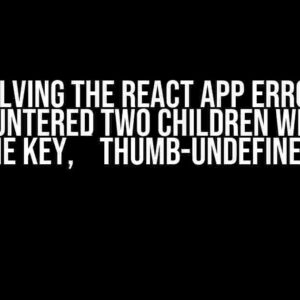If you’re reading this, chances are your React Native app has crashed without throwing any errors, leaving you staring at a blank screen with a mix of frustration and confusion. Don’t worry, we’ve all been there! In this article, we’ll guide you through a step-by-step process to help you identify and fix the issue. Buckle up, and let’s dive in!
Step 1: Gather Information
Before we start debugging, it’s essential to gather as much information as possible about the crash. This will help us narrow down the potential causes and create a plan of attack. Ask yourself:
- What was the last thing you did before the app crashed?
- Was it a specific feature or action that triggered the crash?
- Did you recently update any dependencies or make changes to your code?
- Are you running the app on a physical device or an emulator?
- What’s the operating system and device model (if applicable)?
Write down your answers to these questions, as we’ll refer to them later in our debugging journey.
Step 2: Enable Debugging
To get more information about the crash, we need to enable debugging on our React Native app. You can do this by:
// Add the following code to your android/app/src/main/java/com/yourcompany/MainActivity.java file (for Android)
import com.facebook.react.common.BuildConfig;
import com.facebook.react.ReactInstanceManager;
public class MainActivity extends AppCompatActivity {
private ReactInstanceManager mReactInstanceManager;
@Override
protected void onCreate(Bundle savedInstanceState) {
super.onCreate(savedInstanceState);
mReactInstanceManager = new ReactInstanceManager(this, this.getApplication(), 0, true);
}
}
// Add the following code to your ios/yourproject/AppDelegate.m file (for iOS)
#import "AppDelegate.h"
#import <React/RCTAppDelegate.h>
@implementation AppDelegate
- (BOOL)application:(UIApplication *)application didFinishLaunchingWithOptions:(NSDictionary *)launchOptions {
[RCTAppDelegate initWithDelegate:self];
return YES;
}
@end
This code enables debugging on both Android and iOS platforms. Now, let’s move on to the fun part – analyzing the crash logs!
Step 3: Analyze Crash Logs
Certain operating systems and devices provide crash logs that can help us identify the root cause of the issue. Here’s how to access and analyze them:
Android
To access crash logs on Android, you can use the Android Debug Bridge (ADB) command:
adb logcat -d *:S ReactNative:V
This command will display the logcat output, which may contain error messages related to the crash. Look for any red flags, such as:
- Java exception traces
- Native crashes
- React Native errors
iOS
On iOS, you can access crash logs using Xcode’s built-in debugging tools:
- Open Xcode and navigate to the Organizer window.
- Select the device you’re using from the left-hand sidebar.
- Click on the “Crashes” tab.
- Find the crash log associated with your app and select it.
- Analyze the crash log to identify potential issues.
Take note of any error messages, exception codes, or suspicious behavior in the crash logs. These clues will help us narrow down the possible causes of the crash.
Step 4: Review Recent Changes
Chances are, the crash is related to a recent change you made to your code or dependencies. Let’s review your recent commits and changes:
- Check your commit history and identify the last changes you made before the crash.
- Review your dependencies and ensure they’re up-to-date.
- Investigate any recent changes to your React Native version or plugins.
Did you recently update a dependency or add a new feature? This might be the culprit behind the crash. Try reverting to a previous version or disabling the new feature to see if it resolves the issue.
Step 5: Test and Isolate
Now that we’ve gathered information, enabled debugging, analyzed crash logs, and reviewed recent changes, it’s time to test and isolate the issue:
- Reproduce the crash by performing the same actions that triggered it initially.
- Use React Native’s built-in debugging tools, such as the debugger or React DevTools, to inspect the app’s state and identify potential issues.
- Try commenting out or disabling specific parts of your code to see if the crash persists.
By process of elimination, you’ll eventually identify the root cause of the crash. It might be a tricky bug, but with persistence and patience, you’ll get to the bottom of it!
Common Issues and Solutions
To help you tackle common issues that might cause a crashed React Native app without any error, we’ve compiled a list of potential solutions:
| Issue | Solution |
|---|---|
| Outdated dependencies | Update dependencies to the latest versions using npm or yarn. |
| Conflicting dependencies | Identify and resolve conflicts between dependencies using tools like npm audit or yarn why. |
| Rendering issues | Optimize component rendering by reducing unnecessary re-renders or using shouldComponentUpdate. |
| Memory leaks | Use React Native’s built-in memory tracking tools or third-party libraries to identify and fix memory leaks. |
| Native module issues | Ensure native modules are correctly linked and configured. Use React Native’s built-in linking tool or third-party libraries like react-native-link. |
These are just a few common issues that might cause a crashed React Native app without any error. Remember to stay calm, methodically debug the issue, and don’t be afraid to ask for help if you’re stuck!
Conclusion
A crashed React Native app without any error can be frustrating, but with the right approach, you can identify and fix the issue. By gathering information, enabling debugging, analyzing crash logs, reviewing recent changes, testing and isolating the issue, and considering common issues and solutions, you’ll be well on your way to resolving the problem.
Remember to stay patient, persistent, and creative in your debugging journey. And if all else fails, don’t hesitate to reach out to the React Native community for help. Happy debugging!
Additional Resources
For further reading and troubleshooting, we recommend checking out the following resources:
- React Native’s official debugging documentation
- React Native’s GitHub issue tracker
- The React Native community on Reddit
- Stack Overflow’s React Native tag
Good luck, and happy coding!
Frequently Asked Question
If your React Native app suddenly crashes without any error, don’t panic! Here are some FAQs to help you troubleshoot the issue.
Q1: Why does my React Native app crash without showing any error?
Sometimes, your app might crash due to a silent exception, which doesn’t display any error messages. This can be caused by a variety of reasons, including incorrect native module implementations, incompatible library versions, or even a simple typo in your code.
Q2: How can I debug my React Native app if it crashes without any error?
Enable Remote JS Debugging by adding debugjsRemoterEnabled: true to your app’s Info.plist file. Then, attach a debugger to your app using a tool like React Native Debugger or Chrome DevTools. This will help you identify the exact line of code causing the crash.
Q3: What if my app crashes on launch, and I can’t even attach a debugger?
Try resetting your React Native project by running npx react-native reset and then npx react-native run-ios or npx react-native run-android. This will reinstall your project’s dependencies and reset the environment. If that doesn’t work, try deleting the node_modules directory and running yarn install or npm install.
Q4: Could a crashed React Native app be caused by a memory leak?
Yes, a memory leak can definitely cause your app to crash without displaying an error. Use tools like Xcode’s Instruments or Android Studio’s Memory Profiler to detect memory leaks and optimize your app’s performance.
Q5: What if I’ve tried everything, and my React Native app still crashes without an error?
Don’t worry, you’re not alone! Sometimes, the issue can be tricky to identify. Try searching for similar issues on GitHub or the React Native community forums. You can also consider creating a minimal, reproducible example to share with the community for help.




